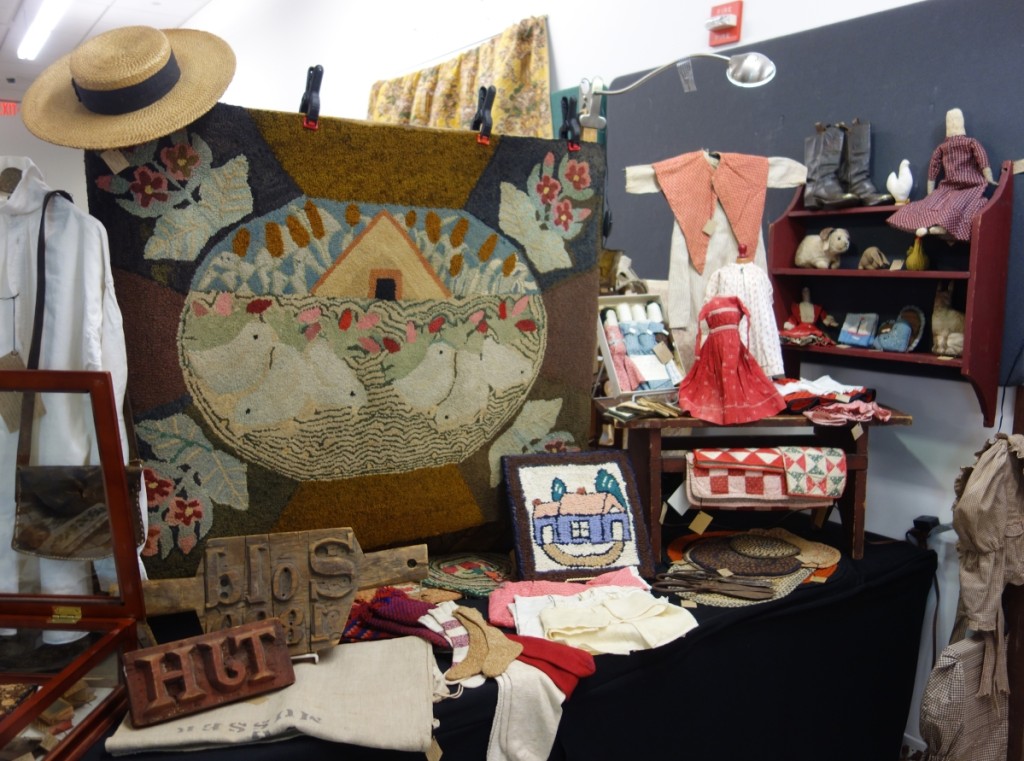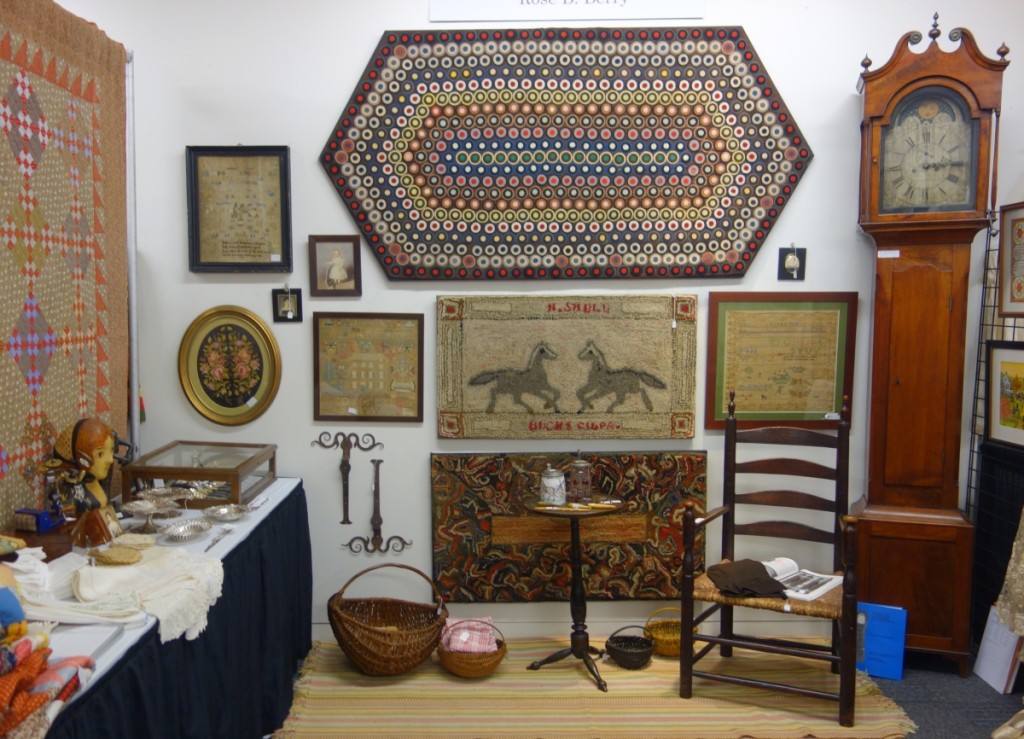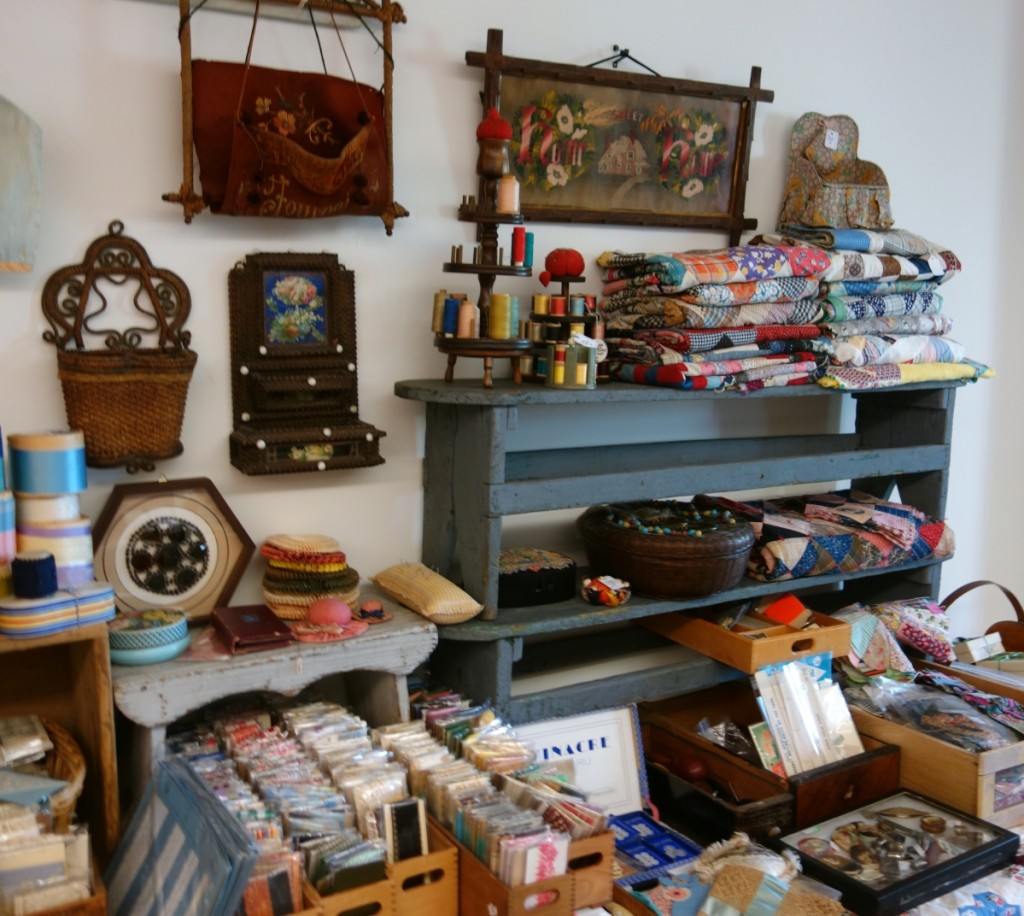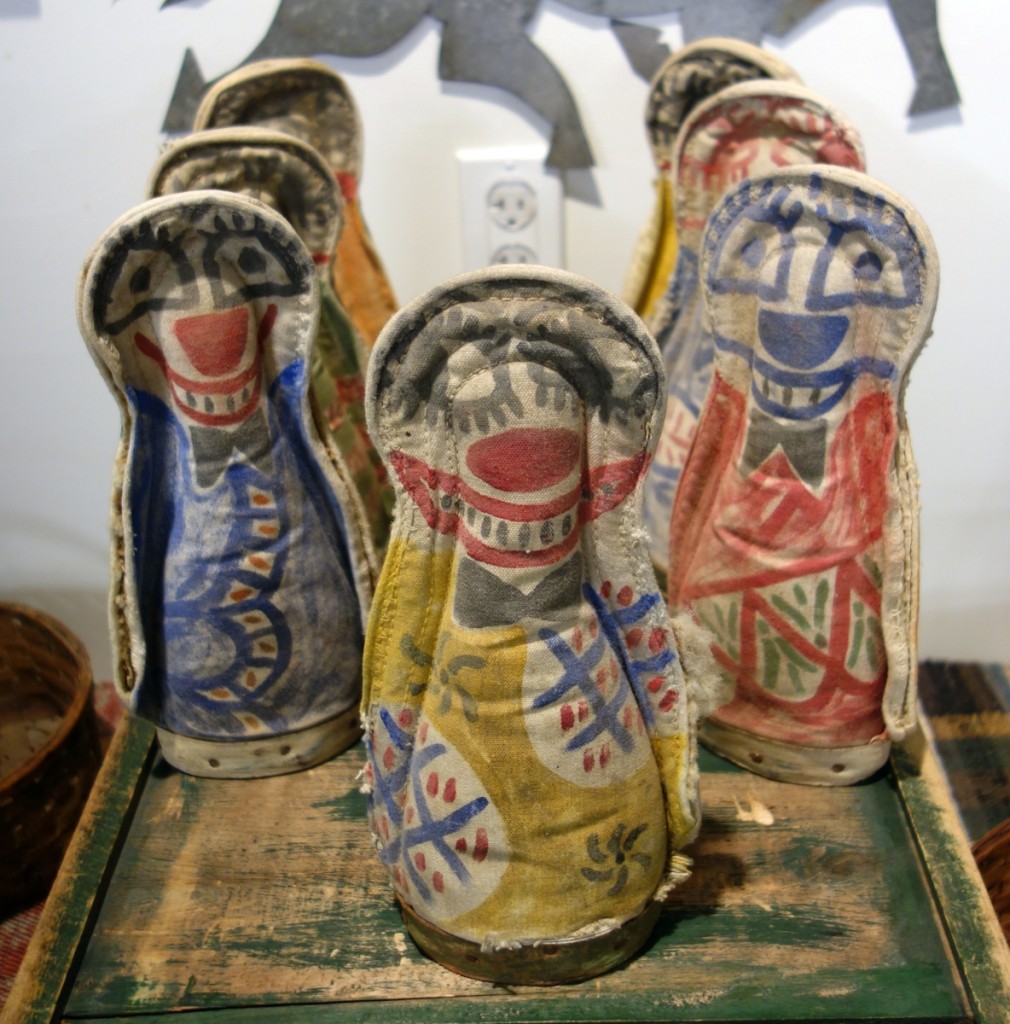Review and Photos by R. Scudder Smith
PENNSBURG, PENN. – Traffic on Seminary Street showed an increase on both Friday and Saturday, May 19-20, as people visited the annual Penn Dry Goods Market at the Schwenkfelder Library & Heritage Center. “We had two good days, our attendance registered 350, up over last year, and our 11 lectures were well attended, most to capacity,” Kathy Lesieur, secretary of the Board of Directors and one of the strong forces behind the Market, said.
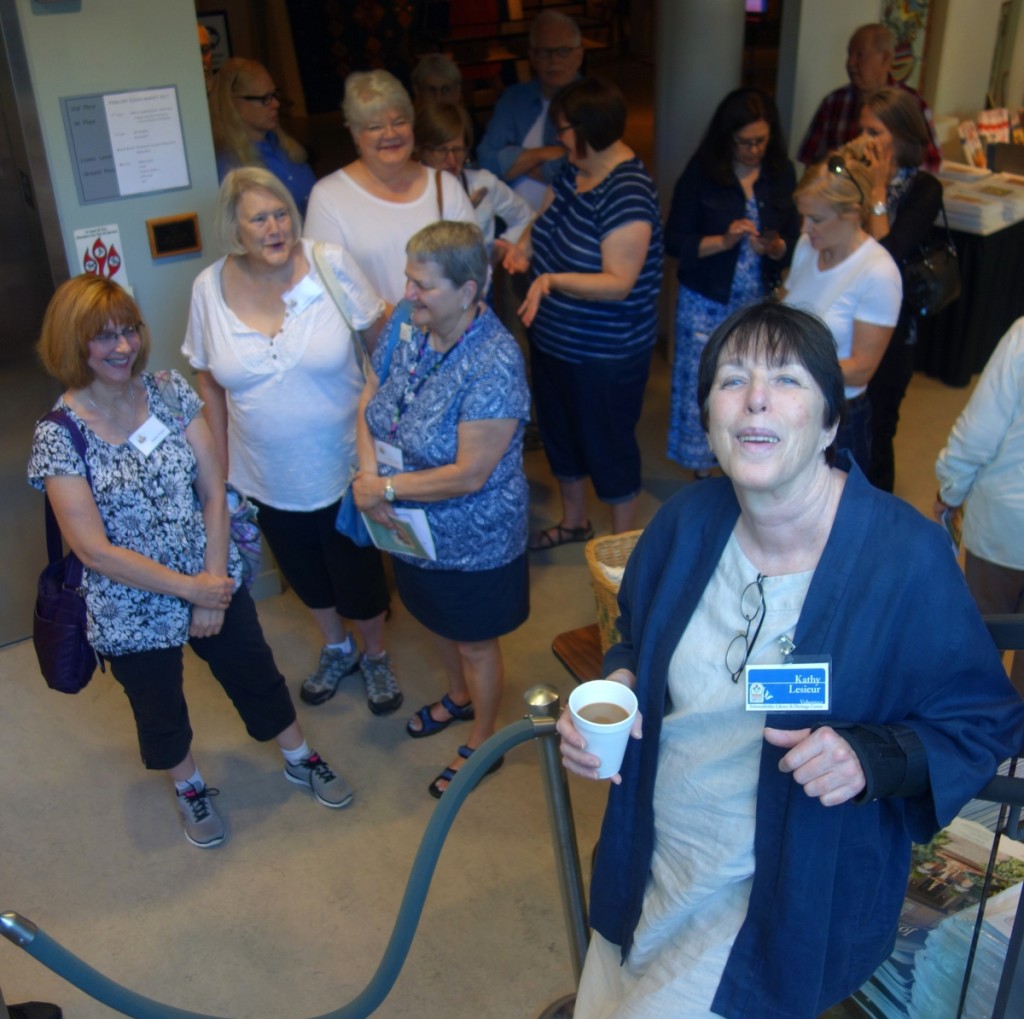
Kathy Lesieur, secretary of the Board of Directors of the Schwenkfelder Library & Heritage Center, getting ready to open the show on Friday morning.
The welcome mat to the Market begins just outside the entrance door where Cafe Applique is set up under tents and coffee is available before the Market opens and a full menu is served from 11 am to 3 pm. The fare includes pork barbecue, hot dogs, soup, salads, chips, brownies, cookies and ice cream, plus more.
The show, with 24 exhibitors, is housed completely on the second floor of the center, with two large rooms holding most of the dealers, and several others in smaller rooms and one in a passageway. “We are thinking about growing by two or three more dealers, but no more. We want to keep it comfortable for both the exhibitors and visitors,” Lesieur said.
This show has a waiting list and many of the exhibitors have been with the show from the start five years ago. Among those dealers are Peggy and John Bartley of Old Farm Antiques in Fleetwood, Penn. “We like this show; it is friendly, easy to do, and a reminder of those old-fashioned shows we all have known,” John said. That seems to speak for everyone.
Just about every object in the booth of Gene Bertolet, Oley, Penn., had a Pennsylvania origin, including a slat basket filled with tin cookie cutters. In addition to this collection, a selection of cookie cutters was lined up across the back of the booth featuring a couple of reindeer, several horses, a rooster, a nesting eagle, chicken and a horse with rider. Redware with slip was represented by several plates, about 8 inches in diameter, along with several miniature plates measuring 3 inches in diameter. Stoneware pitchers carried a variety of blue decoration, a colorful set of carnival cat knock-down figures were standing and a set of Mother Goose alphabet blocks retained the original box. At the front of the booth was a Pennsylvania pie safe on straight legs, about 40 inches tall, with three punched tin sides featuring graduated circles.
Handmade implements designed for working threads, wool and fabric were offered from the corner booth of Chestnut Hall Fine Antiques, Asbury, N.J. including a wooden tabletop loon, circa 1900-10, measuring 26¾ by 23½ inches. Dating from the Nineteenth Century and of Pennsylvania origin was a swift yard winder with umbrella mechanism and a table clamp. Showing some use was a quilt frame, circa 1890-1910.
“It is the largest penny rug I have ever owned and it is from New Jersey,” Rose B. Berry said, pointing to the rug that dominated the back wall of her booth. Shown just under it was a small hooked rug featuring two facing horses from Bucks County, and the corner of the booth was occupied by a tall case clock by John Keim of Reading, Penn. The case is of walnut and it has an eight-day movement. Of interest was a miniature on ivory, dated 1795, of Benjamin Rush, Philadelphia, signed by J. Peale.
Carlson & Stevenson of Manchester Center, Vt., had several stacks of wool knitting thread in many colors, including blue, red, green and orange, and several framed quilt squares hung against the back wall of the booth. A family of paper dolls, neatly folded cloth napkins and a set of five Punch and Judy puppets took up room in one of the back corners. A selection of white tablecloths was displayed in a very early shopping cart, easy to move about the booth.
A small gray painted bench with cutout ends served as a good place to display several pieces of pottery and a wooden painted pail with a stuffed cat peering out in the display of Old Farm Antiques. A six-board blanket chest was also put to use and, with the top open, was hung with a selection of half a dozen quilts and coverlets. A selection of miniature dolls was scattered about a table and a dapple painted rocking horse was awaiting a young rider.
The Gatchellville Store, operated by Linda Sarubin and Caroll Swam in New Park, Penn., is “stocked full to the beams,” according to Linda, and that holds true for the booth at the Market. Every place you looked there were buttons, all sizes, colors and shapes. In addition, Linda pointed out a Nineteenth Century traveling set, a circa 1910 selection of handmade hats with a Baltimore label and a packet of wedding favors, circa early 1900s, showing a fancy dressed bride and groom. Jewelry boxes, sewing kits, and cloth dolls were also shown. And the booth comes with music as Caroll is a talented banjo player, strumming out tunes both at setup and after the Market opened.
Malvern, Penn., dealer Van Tassel Baumann American Antiques was in the usual booth near the entrance to the Market, offering a couple of walls of needlework, including a Pennsylvania Quaker piece by Jane Beale with verse surrounded by flowers, including two pots of flowers along the base. A maple ladderback armchair with exceptional turnings, circa 1750, was from Bergen County, N.J., and displayed on a table was a Sheraton child’s-size chest of drawers in cherry with tiger maple inlaid drawers. It was probably from New York State and dated circa 1830-40.
The Norwoods’ Spirit of America, Timonium, Md., had a couple of Grenfell mats, the smallest, with label, depicted two Eskimos, and nine graduated pin cushions were lined up, giving the appearance of a row of muffins. A trio of fireplace brooms was very patriotic, one with a red handle, the middle in white and the last blue. A tin ABC plate featured Cock Robin, and a basket of velvet fruit in a basket included apples, pear, carrot and melon. As the show opened, Bev Norwood was busy looking for the price tag for the fruit, saying, “It was there just a few minutes ago.” She never did find it and finally opted for making another.
Among the three exhibitors new to the Market this year was Colette Donovan of Merrimacport, Mass., with an American pine storage bench, Pennsylvania origin, Nineteenth Century, resting on ball feet. It had a nice surface of dry old blue paint over the original blue. Several early bonnets were displayed on the bench along with a sad iron on board dating from the Eighteenth Century. A New England scarne with shoe feet dated from the early Nineteenth Century, and a Canton platter held a seed and nut arrangement. The tag noted it was a “one of a kind American folk art.”
From Lansdowne, Penn., Peacock Collection offered racks of buttons, all noted subject and material, including, in part, small steel, tinted metal, pewter, reflectors, woodback, anchors and architectural. Boxes of ribbons were neatly in rows, spools of threads were plentiful and a number of early dresses hung on hangers.
Samplers filled the back wall in the booth of Neverbird Antiques, Surry, Va., and a selection of miniatures included a young girl, silk and paint, circa 1835, of English origin. A copy of Godey’s Lady’s Book & Magazine, July-December 1861, was shown, and a small pin cushion showed a bird with a piece of thread in its mouth. Before leaving the booth we noticed a flip-phone on the table and made mention of it. Bill Subjack was in the process of hanging a sampler, but paused to say, “I grew up being taught that a phone was used for making calls, and that is all I need.” As a fellow flip-phoner, we related perfectly with that reasoning.
A couple of attractive show cases, used by the center to display portions of its collection, were part of the booth filled by Tex Johnson & Son of Adamstown, Penn., and they were used to advantage, showing in one case a black rag doll in a red and white dress under a white apron, and on a shelf below a selection of early children’s shoes. Among pieces in the other case were a couple of spool trees, all hand carved, and an attractive grain-painted miniature cupboard with scalloped base, two small drawers over two large drawers, and the top portion with two glass doors enclosing shelves. This portion was used to display spools of thread.
A special draw to the Penn Market are the textile history lectures that are conducted both days of the Market, with six lectures on Friday and another five on Saturday. Among the topics covered by the speakers were “Fruit and Flower Samplers of Maryland and Delaware,” “Embroidery: The Language of Art,” “Introduction to Coverlets,” “Ribbons and Caps: The History of Moravian Female Headwear” and “A Tale of Two Cities: Needlework Teacher Deborah Hicks Mundall.”
This year a group of 18 ladies from many parts of the country, including Virginia, Arizona and New Jersey, attended, taking advantage of a one-cost offer for several events, including all lectures, admission to the Penn Market, a Friday night dinner with the dealers and a $5 coupon toward lunch. The cost of this package is $250. All lectures last one hour and same-day registration fee for each lecture is $30.
The committee for the Penn Dry Goods Market works hard, always looking for a way to do things better. What they will do for May 18-19, the dates of next year’s Market, remains to be seen. The best thing to do is to mark the calendar, go and enjoy the dealers, the lectures and the outstanding collection on exhibit at the Heritage Center.

